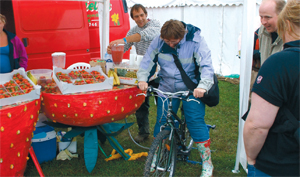Bill Hamblett reveals the sustainable features of Small World Theatre’s building and work.

Small World Theatre aims to be a carbon-neutral theatre, and our new building has many sustainable features. The ‘Air source’ heat pump feeds the under floor heating, 30% of the roof is growing and 70% is recycled slate. Sixty per cent of the water from the roof is harvested into the toilets, showers and washing-up water. The bricks in the lobby were fired about 100 years ago, just a few hundred yards away, from clay dug from this site. Six great Douglas Firs from a local managed woodland hold up the building, and the big oak beams are from Ceredigion. The sand for concrete comes from a couple of miles away and local willow laths form the curving outside lime/clay walls. Recycled paper insulation features across the building. Experimenting with some of these newer technologies enables compliance with rigid new regulations. The local architects and contractors are compelled to come up with imaginative solutions and cost savings. Using local suppliers also keeps the money in the local economy.
It is not just the building that is forging a sustainable future. Many projects are linked to food and culture. The space and the work are interconnected. The bicycle-powered smoothie-making machine (a giant strawberry attached to a bike trailer) is one way in which we are also looking at promoting a healthy lifestyle. The recent community feast was based on produce from our allotment and 200 mackerel that we caught from Cardigan Bay. Environmental art projects continue in schools, too.
As for performances, ‘Cot Myrddin’/‘Merlin’s Coat’ tours schools featuring Merlin’s ‘new’ global warming prophecies. These are accompanied by workshops looking at the complexities of ‘transition towns’; those which are working towards a carbon-neutral future. A new show commissioned by the Forestry Commission looks at how trees act as a carbon sink. Not every subject we deal with will be environmentally focused, but the majority of materials in productions will be. Thirty years ago, Ann Shrosbree was asked by The Centre for Alternative Technology to make a show about ecology (as it was then termed). Since then, our focus has been on shows highlighting environmental issues. Our touring puppet theatre was the educational component in a community forestry project in Sudan, where over a million trees were planted. A forest now stands where once there was a desert. An international strand of work with arts, culture and theatre for development projects now exists in Africa, Asia and the Middle East. We have evolved participatory methods that help communities to have a say in their own development, negotiating behavioral change and raising awareness of rights and responsibilities
To bring stories home and become more Wales focused, we needed this building, not only as a dry working space, but also to reflect our green credentials and participatory processes. A place with no corridors, flexible, accessible, inspiring and inexpensive to run. A place to pass on skills to a successor generation. A creative space for a creative community. Canolfan Byd Bychan/Small World Centre is a place to share our experience in arts and culture, and move towards a carbon-neutral future.
Bill Hamblett is Artistic Director of Small World Theatre. Its participatory approach will continue to feature in work with communities seeking artistic, cultural and environmentally low impact solutions.
w: http://www.smallworld.org.uk



